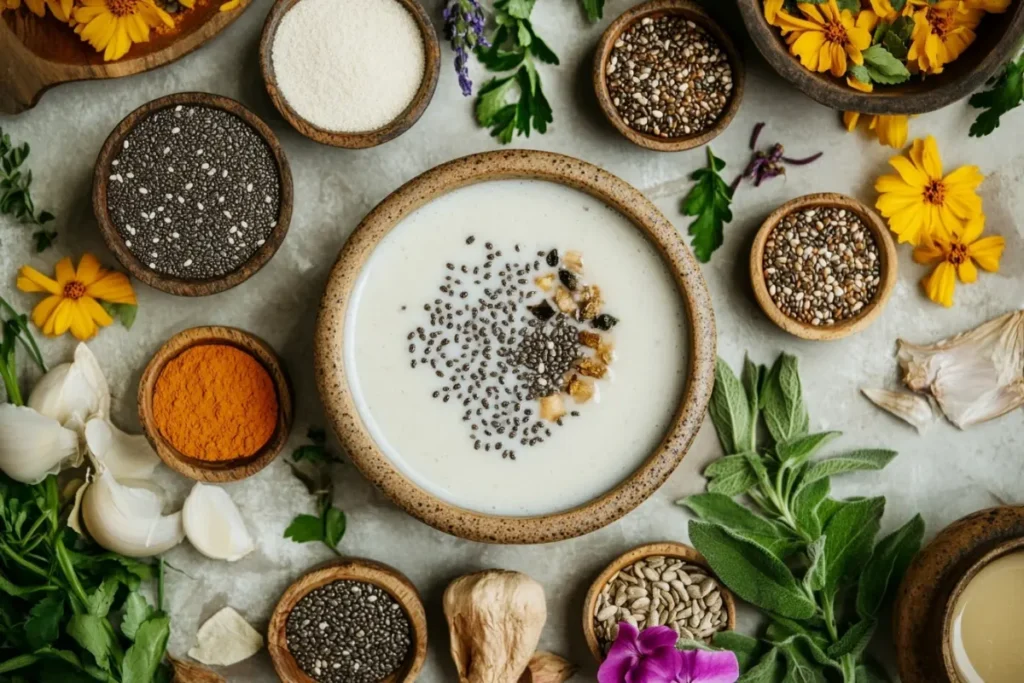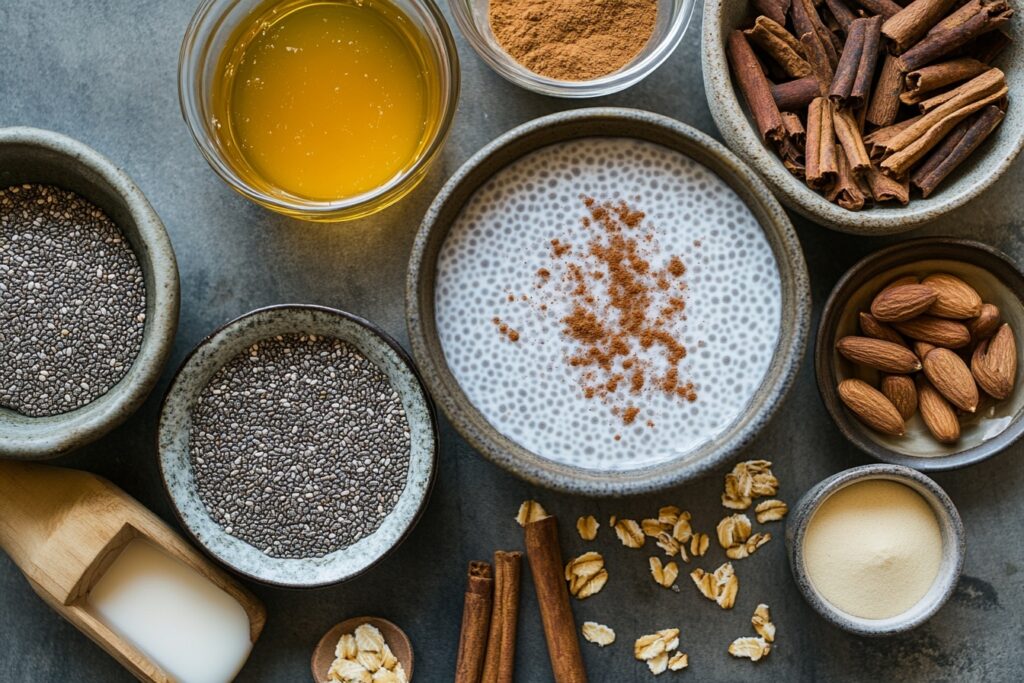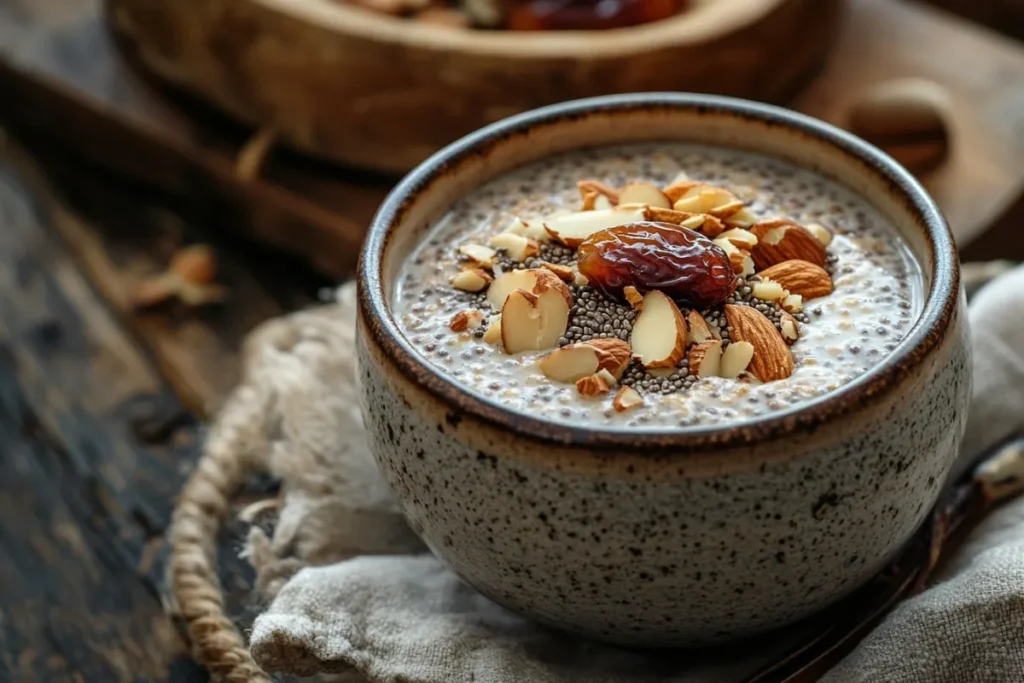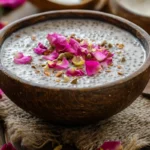Looking for a nourishing breakfast that blends ancient wisdom with modern nutrition? Ayurvedic chia pudding might just be the answer. This unique fusion of Ayurvedic principles and superfood chia seeds creates a meal that supports digestion, balances energy, and promotes harmony between mind and body. Whether you’re striving for better gut health, sustained energy, or simply a delicious and easy breakfast, you’ll love how this pudding aligns with your dosha and daily rhythm.
In this guide, we’ll explore how chia seeds are viewed in Ayurveda, their benefits, how to make Ayurvedic chia pudding, and how to personalize it to your unique constitution.
Learn more about creating simple, healing meals like our 3-ingredient garlic butter to add Ayurvedic flavor to your recipes.
Table of Contents
What Is Ayurvedic Chia Pudding?
Understanding the Ayurvedic Foundation of Chia Pudding
Ayurveda, the 5,000-year-old system of natural healing from India, emphasizes food as medicine. In Ayurveda, meals should be nourishing, easily digestible, and supportive of seasonal and doshic balance.
Chia seeds, though not native to India, are seen through an Ayurvedic lens as cooling, hydrophilic, and rich in prana (life force). When soaked and combined with digestive herbs and spices, chia becomes not just a trendy ingredient—but a deeply balancing food.
Ayurvedic chia pudding takes this versatile seed and prepares it in a way that supports Agni (digestive fire), provides hydration, and builds Ojas—the essential energy responsible for immunity, vitality, and radiance.
How Chia Pudding Fits into Ayurvedic Eating Principles
Here’s how chia pudding aligns with core Ayurvedic food guidelines:
| Ayurvedic Principle | How Chia Pudding Aligns |
|---|---|
| Sattvic Quality | Calms the mind and body with grounding ingredients like nut milk and spices |
| Proper Digestion (Agni) | Made with spices like cardamom or cinnamon to support digestion |
| Dosha Balance | Can be adapted for Vata, Pitta, or Kapha constitutions |
| Seasonal Eating | Can be made warm or cold based on season or body type |
| Hydration & Nourishment | Gel-like texture hydrates tissues and promotes elimination |
A basic chia pudding may be popular in Western health circles, but once adapted with Ayurvedic principles, it becomes a therapeutic elixir suitable for mindful daily nourishment.
Ayurvedic Perspective on Chia Seeds

What Ayurveda Says About Chia Seeds and Their Qualities (Guna, Virya, Vipaka)
Although chia seeds are not mentioned in ancient Ayurvedic texts, modern practitioners analyze them based on traditional Ayurvedic principles. In Ayurveda, every food is described by its:
- Guna (qualities)
- Virya (potency)
- Vipaka (post-digestive effect)
- Rasa (taste)
Let’s break down how chia seeds rank across these categories:
| Ayurvedic Element | Chia Seed Characteristics |
|---|---|
| Rasa (Taste) | Astringent, Mildly sweet when combined with milk or fruit |
| Guna (Qualities) | Heavy, Moist, Slimy, Sticky (when soaked) |
| Virya (Potency) | Cooling – great for reducing heat and inflammation |
| Vipaka (Post-digestive effect) | Sweet – nourishing and rebuilding |
Due to their cooling nature and mucilaginous texture, chia seeds are ideal for Pitta dosha. However, they can also benefit Vata when combined with warming herbs like cinnamon or ginger, and support Kapha when used in small portions with digestive stimulants like clove or black pepper.
Balancing the Doshas: Are Chia Seeds Good for Vata, Pitta, and Kapha?
Ayurveda identifies three primary body types or doshas—Vata, Pitta, and Kapha. Each person has a unique constitution, and the foods we eat should help maintain our natural balance.
Here’s how chia seeds interact with each dosha:
| Dosha | Effect of Chia Seeds | Recommended Add-ins |
|---|---|---|
| Vata (air + ether) | Slightly aggravating due to cold and damp nature | Add warm milk, cinnamon, dates, cardamom |
| Pitta (fire + water) | Highly beneficial due to cooling effect | Add coconut milk, rose water, aloe vera gel |
| Kapha (water + earth) | Can aggravate due to heaviness | Add ginger, nutmeg, minimal liquid, no added sugar |
Important Tip: Always soak chia seeds. Unsoaked seeds may aggravate Vata and hinder digestion.
By understanding how chia interacts with your body type, you can tailor your chia pudding into a healing recipe instead of a generic trend. Ayurveda teaches that there’s no one-size-fits-all food. It’s how you prepare and combine ingredients that creates wellness.
Health Benefits of Ayurvedic Chia Pudding
Ayurvedic Chia Pudding as a Healing, Sattvic Superfood
One of the most powerful qualities of Ayurvedic chia pudding is its versatility in healing. When prepared according to Ayurvedic principles, this pudding does much more than just fill you up—it nurtures your body, calms the mind, and supports balance across your doshas.
Chia seeds are rich in omega-3 fatty acids, antioxidants, soluble fiber, calcium, and magnesium—making them ideal for strengthening tissues and supporting energy without over-stimulating the system.
In Ayurveda, foods that are hydrating, smooth in texture, and naturally sweet are considered building and restoring. Chia pudding—when soaked and combined with herbs like ashwagandha, turmeric, or cardamom—transforms into a truly sattvic meal that promotes clarity, calm, and resilience.
Digestive, Detoxifying, and Hydrating Properties
Let’s take a deeper look at why ayurvedic chia pudding is an ideal food from a digestive standpoint:
| Benefit | Ayurvedic Explanation |
|---|---|
| Digestive Support | The slippery texture of soaked chia calms inflamed gut lining and supports regular elimination |
| Hydration | Chia seeds can absorb up to 12x their weight in liquid, delivering deep tissue hydration—especially beneficial for Vata and Pitta types |
| Detoxification | The fiber in chia binds toxins (Ama) in the digestive tract, helping flush them gently out of the system |
| Energy & Vitality | Builds Ojas, the subtle essence of life, due to its nourishing and grounding nature |
Unlike heavy breakfasts that slow digestion, ayurvedic chia pudding provides light yet sustaining energy. It also helps stabilize blood sugar levels, making it ideal for those dealing with midday crashes or sluggish Agni.
Looking for inspiration? Try our refreshing sorbet mocktail to cool Pitta dosha alongside your chia pudding.
By including ayurvedic chia pudding in your routine—especially when tailored with dosha-balancing ingredients—you’re not just eating breakfast. You’re practicing self-care that aligns with your constitution, your energy, and the season.
How to Make the Best Ayurvedic Chia Pudding

Basic Ayurvedic Chia Pudding Recipe for All Doshas
Creating ayurvedic chia pudding at home is both simple and powerful. The key lies in the combination of soaked chia seeds, dosha-specific liquid, digestive spices, and sattvic sweeteners. This approach turns a regular chia dish into a true Ayurvedic tonic.
Here’s a universal recipe you can customize for your body type:
Ingredients:
- 3 tablespoons chia seeds (soaked)
- 1 cup warm almond milk or coconut milk
- 1/2 teaspoon ground cardamom
- 1 pinch dry ginger or cinnamon
- 1 teaspoon maple syrup or soaked dates (optional)
- Optional toppings: shredded coconut, chopped figs, ghee, rose petals
Directions:
- Soak chia seeds in your liquid of choice for at least 30 minutes or overnight.
- Stir in the digestive spices and sweetener.
- Warm gently before serving in cooler months (great for Vata and Kapha).
- Top with seasonal fruits, herbs, or Ayurvedic garnishes.
This base recipe creates a cooling, grounding, and hydrating meal, perfect for breakfast or a light evening meal.
The Best Ayurvedic Liquids for Chia Pudding by Dosha
Liquid choice is essential in ayurvedic chia pudding, as it sets the tone for how your body digests and assimilates the nutrients.
| Dosha | Best Liquid | Why It Works |
|---|---|---|
| Vata | Warm almond milk, oat milk with ghee | Calms dryness, supports warmth and lubrication |
| Pitta | Coconut milk, rosewater-infused water | Cools excess heat and acidity |
| Kapha | Spiced water (with ginger, clove), light rice milk | Stimulates sluggish digestion and clears excess moisture |
Using the right base helps the pudding remain tridoshic-friendly and enhances its healing properties.
Don’t miss our seasonal Ayurvedic breakfast drinks to complement your chia meal with dosha-specific hydration.
By choosing the proper liquid, spice, and serving method, you can transform a trendy recipe into an authentic ayurvedic chia pudding that strengthens digestion and restores balance.
When and How Often Should You Eat Chia Pudding?
Can You Eat Ayurvedic Chia Pudding Every Day?
A common question people ask is, “Is it okay to eat chia pudding every day?” From an Ayurvedic perspective, the answer is: it depends on your dosha, digestion, and season.
While ayurvedic chia pudding is a highly nutritious, sattvic food, Ayurveda never promotes eating the same food daily, without considering seasonal variation and individual constitution. Repetition can disturb Agni (digestive fire), especially if the food is too cold or too damp for your body type.
That said, if prepared with balancing spices and warmed when needed, chia pudding can be eaten regularly—especially by Pitta types and during hot seasons.
For example:
- Vata types may enjoy chia pudding 2–3 times per week, ideally warm and spiced.
- Pitta types can eat it more frequently, as chia is naturally cooling and hydrating.
- Kapha types should eat it sparingly, no more than once or twice a week, with pungent spices to enhance digestion.
Listening to your body is key. Ayurveda encourages intuitive eating—if your digestion feels off, bloated, or sluggish, it’s time to pause or modify.
Best Time to Eat Ayurvedic Chia Pudding
The timing of meals is crucial in Ayurveda. To get the most benefit from ayurvedic chia pudding, follow this guidance:
| Time of Day | Is It Recommended? | Ayurvedic Reason |
|---|---|---|
| Morning (7–9 AM) | ✅ Best time | Digestive fire is increasing and body needs grounding, hydrating foods |
| Afternoon | ❌ Not ideal | Body is already digesting lunch—chia may feel heavy |
| Evening (before 6 PM) | ⚠ Only if warmed and spiced | Cold chia pudding at night can weaken Agni, especially in Vata/Kapha |
Warm chia pudding for Vata or Kapha in the morning is especially balancing in cooler months. For Pitta, a chilled version in summer can be wonderfully pacifying.
So yes, ayurvedic chia pudding can be part of your weekly or even daily routine—with the right spices, timing, and preparation style. Remember: it’s not about repetition—it’s about rhythm and balance.
Who Should Avoid Chia Seed Pudding? Precautions and Personalization

Is Ayurvedic Chia Pudding Suitable for Everyone?
Even though ayurvedic chia pudding is considered a nutrient-rich and sattvic food, it may not be suitable for everyone in all situations. Ayurveda teaches that even the most nourishing ingredients can become imbalancing if they don’t align with your Agni (digestive fire), current doshic imbalance, or seasonal condition.
Here’s when caution is advised:
- Weakened or slow digestion (Manda Agni) – The slippery, heavy texture of soaked chia can dampen digestive fire, especially if eaten cold or in excess.
- Vata imbalance – Chia’s cooling, drying, and expansive properties can aggravate Vata unless combined with warming herbs and served warm.
- Respiratory congestion or excess Kapha – Due to its mucilaginous nature, chia may increase kapha-related symptoms like sinus congestion or sluggish metabolism.
- During pregnancy – While generally safe in moderation, excessive fiber and cooling foods may not always suit pregnant individuals—consult an Ayurvedic practitioner.
- People on blood thinners – Chia seeds are rich in omega-3s, which can naturally thin the blood. Consult your doctor if you’re on anticoagulant medication.
How to Modify Ayurvedic Chia Pudding for Your Needs
If you’re concerned about digestion or imbalance, Ayurveda offers countless ways to modify your food. Here are easy tweaks to make ayurvedic chia pudding more suitable:
| Concern | Modification |
|---|---|
| Weak digestion | Add fresh grated ginger or trikatu powder; serve warm |
| Vata imbalance | Use almond milk with cinnamon and ghee; top with stewed dates |
| Kapha excess | Avoid cold versions; use clove, nutmeg, and a dash of black pepper |
| Sensitive to fiber | Soak chia thoroughly overnight to ease digestion |
| High Pitta | Use cooling herbs like rose, fennel, or aloe juice with coconut milk |
When prepared mindfully, ayurvedic chia pudding becomes accessible even to those with sensitive digestion or constitutional challenges. The key is customization—one of Ayurveda’s most powerful gifts.
Now that we’ve explored who should avoid it—and how nearly everyone can enjoy it with the right preparation—let’s move to the FAQ Section, where we answer your top questions about this healing, dosha-friendly breakfast.
FAQs – Ayurvedic Chia Pudding Insights
u003cstrongu003eWhat does Ayurveda say about chia seeds?u003c/strongu003e
Though chia seeds aren’t found in classical Ayurvedic texts, modern Ayurveda classifies them by their qualities. Chia is considered u003cstrongu003ecooling, heavy, and hydratingu003c/strongu003e, with a sweet post-digestive effect. These properties make them ideal for u003cstrongu003ePitta doshau003c/strongu003e, but they can also benefit Vata and Kapha when prepared with warming or digestive spices. Soaked chia seeds are especially valued for u003cstrongu003ecalming inflammationu003c/strongu003e, u003cstrongu003esupporting eliminationu003c/strongu003e, and u003cstrongu003erestoring hydrationu003c/strongu003e to dry tissues.
u003cstrongu003eIs it okay to eat chia pudding every day?u003c/strongu003e
u003cstrongu003eAyurvedic chia puddingu003c/strongu003e can be enjoyed daily if it’s tailored to your dosha and season. For most people, eating it u003cstrongu003e3–5 times a weeku003c/strongu003e with appropriate spices and warm or cool liquids based on your constitution is beneficial. However, Ayurveda discourages eating the same food the same way every single day. If you listen to your digestion and rotate ingredients mindfully, daily consumption is often fine.
u003cstrongu003eWho should not eat chia seed pudding?u003c/strongu003e
People with u003cstrongu003elow digestive fire (Agni)u003c/strongu003e, u003cstrongu003eKapha imbalancesu003c/strongu003e, or a u003cstrongu003eVata constitution during winteru003c/strongu003e should be cautious with chia pudding. Unsoaked or cold versions can lead to bloating, mucus, or sluggish digestion. It’s also advised to avoid excess chia during pregnancy or while on blood-thinning medications unless cleared by a doctor or Ayurvedic practitioner.
u003cstrongu003eWhat is the best liquid for chia seed pudding?u003c/strongu003e
The u003cstrongu003ebest liquidu003c/strongu003e depends on your dosha:u003cbru003eu003cstrongu003eVatau003c/strongu003e: Warm almond milk with cinnamon or gheeu003cbru003eu003cstrongu003ePittau003c/strongu003e: Coconut milk or rosewater-infused wateru003cbru003eu003cstrongu003eKaphau003c/strongu003e: Light spiced water (ginger, clove) or warm oat milku003cbru003eAlways choose a u003cstrongu003eliquid that supports your digestion and temperature balanceu003c/strongu003e. This personalization transforms basic chia pudding into a true u003cstrongu003eayurvedic chia puddingu003c/strongu003e.
Conclusion – Embrace the Healing Simplicity of Ayurvedic Chia Pudding
In a world of fad diets and complicated meal plans, ayurvedic chia pudding offers a refreshing return to simplicity. Rooted in tradition yet adaptable to modern life, this healing breakfast brings together hydration, balance, and nourishment. Whether you’re looking to improve digestion, calm inflammation, or simply enjoy a mindful, nutritious start to your day, this humble pudding can be your daily act of self-care.
Remember: the power lies in how you prepare it. Adjust the temperature, the spices, the toppings, and the timing—and you’ll unlock a meal that truly honors your body.
Check out our hearty chicken spaghetti recipe for a grounding evening meal that complements a light chia pudding breakfast.*
“For more cozy comfort food ideas, visit our Facebook page for daily inspiration. You can also find more easy recipes on our Pinterest boards to keep your meals exciting.”

Ayurvedic Chia Pudding
Ingredients
Pudding Base
- 3 tablespoons chia seeds Must be soaked
- 1 cup warm almond milk or coconut milk Choose based on your dosha
- 1/2 teaspoon ground cardamom Supports digestion
- 1 pinch dry ginger or cinnamon Optional for warmth and digestion
- 1 teaspoon maple syrup or soaked dates Optional sweetener
Optional Toppings
- 2 tablespoons shredded coconut For garnish
- 2 tablespoons chopped figs Add for sweetness
- 1 tablespoon ghee Enhances richness
- 1 tablespoon rose petals For decoration
Instructions
Preparation
- Soak chia seeds in warm almond milk or coconut milk for at least 30 minutes or overnight.
- Stir in the ground cardamom and dry ginger or cinnamon.
- Warm gently before serving if desired.
- Top with shredded coconut, chopped figs, ghee, or rose petals before serving.
